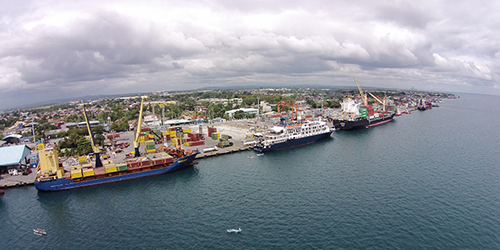-
The Philippine Ports Authority is eyeing the same domestic cargo rates for Tier 2 and Tier 3 ports
-
Proposed rates for foreign cargoes at Tier 2 ports will be equal to what the Cebu Port Authority charges but plus 10%
The Philippine Ports Authority is proposing cargo-handling base rates for Tier 2 ports bidded out under the agency’s new terminal management framework.
For foreign cargo rates, PPA is eyeing adoption of the Cebu Port Authority tariff but with an additional 10%. Seven percent of the 10% represents the consumer price index (all items adjustment factor from 2019 to 2021) and 3% unforeseen events that may affect the cost of investment such as the pandemic or Russia-Ukraine war, PPA Commercial Services Department acting manager Leila Martinez said in a March 11 virtual hearing.
The proposed tariff for domestic cargoes at Tier 2, on the other hand, will mirror that of Tier 3 “for uniformity, as Tier 2 and Tier 3 mostly handle domestic cargoes,” Martinez added.
The base tariff for Tier 3 ports is already in place at some ports whose management contracts were bidded out by PPA in 2020 and 2021. Embodied under PPA Administrative Order (AO) No. 10-2019, the Tier 3 tariff is patterned after Cagayan de Oro port’s, which levies the highest rates among PPA-supervised ports. Several industry groups are, however, pushing the suspension of implementation of AO 10-2019 pending consultation, claiming Tier 3 rates are much higher than previous ones.
READ: PPA uniform rules on port tariff out
While proposed foreign cargo rates at Tier 2 ports such as Iloilo and Davao (Sasa) are 10% higher than Cebu port’s, they would in the end still be “actually much lower” than what shippers currently pay, Martinez said.
Right now, she explained, import shipments destined for Iloilo port are usually first discharged at Manila or Cebu, then transferred to a domestic terminal before being shipped finally to Iloilo. The transhipment translates to high shipping costs.
Once modernized by new operators, Tier 2 ports are expected to attract direct international calls, erasing a big chunk of costs, including transhipment.
The proposed tariff for Tier 2 ports, are still subject to evaluation of the PPA board technical working group and for approval of the PPA Board.
Asked how much increase the proposed tariff will bring compared to existing rates in Davao and Iloilo ports, Martinez provided these examples.
Davao port rates (2013 level):
- 20-footer loaded will be 252% higher from P1,735.50 to P6,113.80 under the PPA Tier 2 proposal
- 40-footer will be 180% higher from P3,304 to P9,252.10
- Non-containerized general cargo will be 81% higher from P189 to P342.10
- Palletized non-containerized will be 59% higher from P139.10 to P221
Iloilo port rates:
- 20-footer loaded will be 430% higher from P1,154.50 to P6,113.80 under the PPA Tier 2 proposal
- 40-footer will be 355% higher from P2,031.50 to P9,252.10
- Non-containerized general cargo or bulk will be 150% higher from P135.45 per metric ton (MT) to P342.10 per MT
Martinez pointed out the proposed tariff already combines arrastre and stevedoring rates, the same arrangement under Tier 3 port tariff.
She said a competitive tariff is needed to attract investments since Tier 2 port operators invest a massive amount of money over the length of the 20-year contract awarded to them.
Stakeholders have until March 18 to submit their position papers on the PPA proposal. Another public hearing is set on March 14.
Of the more than 100 industry stakeholders and PPA officials and personnel who attended the virtual hearing, only a few made their sentiments about the tariff proposal known in a survey: 14 participants supported the proposed tariff, ten were against, and two abstained.
Under PPA Administrative Order No. 03-2016, the Port Terminal Management Regulatory Framework outlines guidelines for awarding terminal management contracts, and prescribes categorizing investments into six tiers for easier determination of the investment arrangements for a port.
READ: PPA to implement soon new rules on award of terminal contracts
Winning contractors for Tier 2 ports are responsible for the port’s physical landside infrastructure, above ground fixtures and semi-fixtures, and mobile-handling equipment. On the other hand, PPA is responsible for physical undersea infrastructure. The concession period for Tier 2 port terminal management contracts is 20 years. – Roumina Pablo





